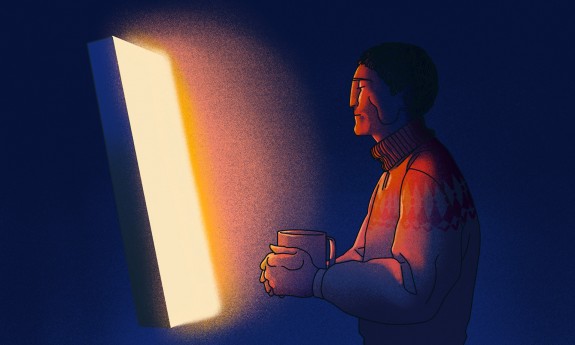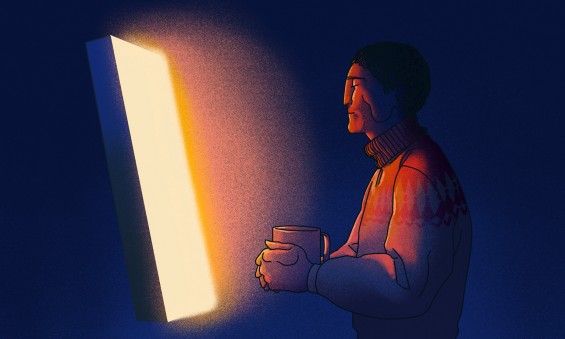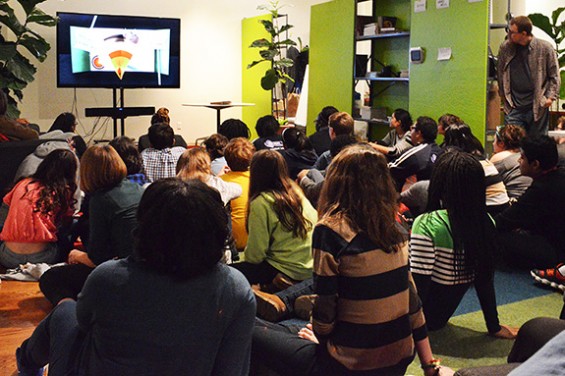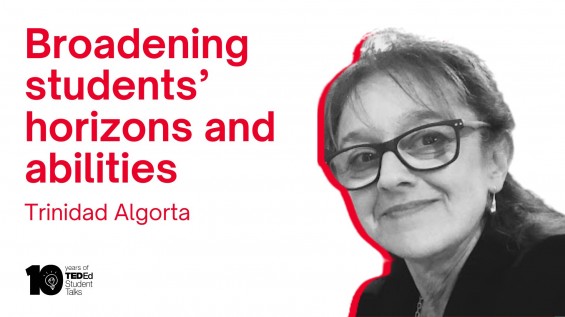
Here’s why you get gloomy in the winter — and what you can do about it
If the darkening evenings and turning leaves induce a mild sense of dread in you every year, you’re not alone.
With the arrival of winter, many of us experience Seasonal Affective Disorder — which bears the appropriate acronym of SAD — and can bring on a depressed mood, loss of interest in things that you normally enjoy, and changes in sleep and appetite. While there aren’t conclusive figures, it is thought to affect between one and nine percent of the population, depending on where you live.
Although we may think of it as being a distinct affliction of its own, SAD is actually classified as either bipolar or major depressive disorder, but with a seasonal pattern. This means that people who experience it feel much worse in the fall and winter and relatively balanced or potentially even manic in the summer months, explains Kathryn Roecklein PhD, an associate professor of psychology at the University of Pittsburgh who studies the condition.
“Depression itself is pretty episodic,” says Roecklein. “You have a period of it, and then it goes away. The distinction [with SAD] is the seasonal recurrence.” It also appears that SAD is two to four times more common amongst women.
Even though we are making greater efforts as a society to recognize the importance of our mental health, it can be tempting to dismiss SAD as a touch of the “winter blues” and to try to get on with life as usual. But the best approach, Roecklein says, is to accept and recognize that it’s something that we may genuinely suffer from — and need treatment for. Just as we would for heart disease or diabetes.
Why does winter make us SAD?
The story of SAD starts with our circadian rhythm — our internal body clock that tells us when to eat, go to sleep and wake up.
For the most part, we tend not to think too much about this system unless we have an unexpectedly late night or take a long-haul flight. But chronobiologist Emily Manoogian PhD says it plays a much more significant role.
“The circadian system is directly tied to how our brain functions, and this affects our cognitive ability, our behavior, our mood and our ability to remember things,” says Manoogian, who researches circadian rhythms at the Salk Institute for Biological Studies in California. “The circadian system is important for making sure that throughout your body and brain, regions are talking to each other the way that they should be and everything is balanced. We know that circadian disruption is heavily associated with every form of affective disorder — such as major depressive disorder, bipolar disorder, etc.”
Increased darkness in the fall and winter months is something that humans on much of the planet have experienced for thousands of years, but our technological advancement — in particular, artificial light — is interfering with this natural occurrence. Light is one of the most powerful stimuli for our circadian systems, and since the advent of electricity we’ve been sending our bodies a lot of mixed messages.
“This environment that we’ve created is inherently disruptive — it’s not lights on and off at a constant time to allow for a proper rest for our body; it’s lights on when we need to be up for work on some days, and then off later on other days,” explains Manoogian. “That creates this kind of social jetlag. That’s also going to make it a lot harder to sleep, and it can compromise health over time.”
Manoogian is also not a fan of daylight savings time. She says, “It shifts our exposure to sunlight later in the day and thus shifts our biological clocks. In the summer, we are getting sunlight later than we should, and when days are shorter, we are waking up in darkness. But the problem is that we still have to start work or school at the same times. This means that our schedules and our body are on different times, and this disrupts the circadian system.”
Although there is no evidence connecting it directly to SAD, daylight savings time is known to be widely disruptive to society and potentially even associated with cardiac health risks. There’s a growing movement to do away with the twice-annual time switch in several Canadian provinces, where Saskatchewan and (as of 2020) the Yukon Territory stick to the same time year-round, and similar proposals are being considered in other jurisdictions around the world.
What can you do?
As with any disorder, your treatment depends in part on severity. If SAD is significantly disrupting your life or making you feel as though life is not worth living anymore, it’s deeply important for you to reach out immediately to a mental health professional who can support you. Roecklein says that effective treatment options include taking medication, receiving cognitive behavioral therapy tailored to treating SAD, or using a SAD lamp (which delivers a higher dose of light than regular indoor lighting), but they should be explored under professional guidance.
If you’re wondering what to do because you’ve already bought a SAD lamp to use on your own, Roecklein says that there could be side effects. The most likely one, which is mild, is that you will feel it isn’t effective. This doesn’t mean that it can’t be the right therapy for you in conjunction with professional guidance — for instance, you could be using it at the wrong times or for the wrong duration. At the other end of the scale, mania is a very rare but significant side effect of improper use.
However, there are some relatively easy things you can do to support your circadian rhythms in everyday life. And while these aren’t guaranteed treatments for SAD, they can help give your body a stabilizing sense of routine.
Keep a consistent schedule, especially if you work from home
This doesn’t need to be a rigid, planned-down-to-10-minute increments affair; it’s more about keeping the stimuli that speak to your circadian system arriving roughly when it expects them, says Manoogian. Social interactions and food are two important circadian cues, so having regular mealtimes and breaks where you make a phone call, go for a walk or talk with other members of your household can really help.
Exercise is another important cue
It’s hard to get — and stay — motivated during a winter of pandemic-related restrictions, so any exercise is better than no exercise at all, emphasizes Manoogian. However, if you do choose to exercise outside, she says that the morning is a good time for your body to get some much needed natural light.
The only time for you to avoid exercising, if possible, is right before bed. When you do, it sends a confusing message to your body that night is a time to be active rather than to prepare for sleep.
Maximizing your light exposure is key
How much light we experience at different times of the day is important. Increasing the amount of light you get in the morning is helpful, whereas increasing your light exposure in the evening can be counterproductive.
So if your morning commute has changed from an hour in the car or on transit to a quick switch from your bed to your desk, you’re losing out on a lot of daylight that you are used to receiving just when you need it most. Taking a morning walk before you start your day, or even sitting near a bright window for the first half of your day can really help.
At night, reducing your light exposure and making your sleeping environment as dark as possible is also of huge benefit, explains Roecklein. “Most circadian biologists and sleep researchers I know have blackout shades and no night lights in their rooms — we don’t even have clocks with illuminated screens.”
No, it’s not just you — 2020 may be making your SAD worse
It’s difficult to separate the impacts of factors like the COVID-19 pandemic, the associated economic downturn and the psychological toll of the current political climate. But Roecklein has noted, at least anecdotally among the people in her SAD study, that there seems to be a higher instance of what psychologists refer to as “negative anticipatory cognitions” — where people consistently expect things to be worse in 2020 than in other years.
Roecklein also notes that experiencing negative life events — such as a bereavement, job loss or some other major change that requires large adjustment — as well as reduced opportunities for social and physical activity are additional risk factors for SAD. These areas of our lives have all been significantly impacted by COVID-19, so she and her colleagues anticipate a higher risk of people experiencing SAD this year.
However, there may be one small silver lining to the current situation, says Manoogian. While routine is very important for our bodies, a regular 9-5 work day can be very unnatural for those of us who aren’t morning people.
“The typical workday schedule is an artificial time that not everyone is able to stick to,” she explains. “If you work from home and you have a little bit of freedom about when you work, this could provide a very interesting opportunity for you to actually coordinate your schedule more with your internal clock.”
Sometimes it’s OK to doomscroll
Lastly, Roecklein wants to stress that although a routine is important, we are living through monumental events that are unfolding right before our eyes. And if we occasionally want to stay up a few hours later to feel better informed or more connected to other people experiencing the same thing… that’s actually fine.
“We take a moment to care for ourselves by thinking about the pros and cons. So there may be some nights where staying up late and doomscrolling is a choice one might make for good reasons,” says Roecklein. “But then on other nights, when we think about what we want most for ourselves — like better energy in the morning, a more positive mood, better alertness for the endless Zoom meetings — we might be more motivated to turn off devices, turn off the TV, dim the lights, and do all of those things that can help you wind down. Give yourself the chance to make that decision, and make the decision that’s right for you.”
Watch Emily Manoogian’s TEDxSanDiegoSalon Talk on your circadian clock here:
ABOUT THE AUTHOR
Mary Halton is Assistant Ideas Editor at TED, and a science journalist based in the Pacific Northwest.
This post was originally published on TED Ideas. It’s part of the “How to Be a Better Human” series, each of which contains a piece of helpful advice from someone in the TED community; browse through all the posts here.




